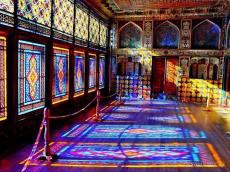|
|
TODAY.AZ / Arts & Entertainment
Shabaka - Azerbaijan's traditional stained-glass art
13 June 2022 [15:37] - TODAY.AZ

By Laman Ismayilova
For centuries, houses with stained-glass windows have exploded in popularity worldwide, Azernews reports.
In Azerbaijan, this ancient art form continues to live thanks to the efforts of skilled craftsmen.
Shabaka art is a wooden lattice of pieces of colored glass, held together without glue or a single nail.
From the 11th-12th centuries, this art form was widespread in cities such as Shaki, Shusha, Ordubad, Baku, Ganja, and others.
The surface dimensions of the shabaka can vary from a few square centimeters to several square meters.
According to compositions, shabaka is divided into "jafari", "sakkiz", "onalti", "gullyabi", "shamsi", "gelu" and "bendi-rumi".
Wooden parts are made of hardwoods - beech, walnut and oak. Shabaka patterns symbolize the sun, the energy of life, the eternal flow of time, and the infinity of the universe.
The revival of the shabaka art is associated with such folk craftsmen as Abdulhuseyn Babayev (1877-1961) and Ashraf Rasulov (1928-1997).
Mehdi Mehdiyev (19th century), Shahbuzla Abuzer Badalov (18th-19th centuries), Abbasgulu Sheki (19th century), and many other folk craftsmen also contributed to the promotion of Azerbaijan's stained-glass art.
Palace of Sheki Khans
The Palace of Sheki Khans is among some of the most striking examples of this centuries-old art form.
In 2019, the Historic Center of Shaki with the Khan's Palace was inscribed as a UNESCO World Heritage Site.
This majestic royal palace was built in the 18th century without a single nail with luxurious wall paintings and openwork windows.
Shabaka fills walls and window openings of halls and rooms in the Palace of Sheki Khans.
Stained-glass windows of central halls and side rooms open on the facade. These stained glass windows are a special feature of the palace's architecture.
The summer residence is renowned for its majestic interior. Large portions of the facade of the residence, including the entire southern elevations of the central halls on both floors, are covered by a mosaic of colored glass set in a wooden latticework (shabaka).
The interior walls of the residence are covered entirely with frescoes painted at different times during the eighteenth century.
Nakhchivan Khans' Palace
Nakhchivan Khans' Palace is another beautiful example of shabaka art.
Built in a special order and combining many types of folk art, Nakhchivan Khans' Palace is distinguished by its original architectural style.
The palace was the residence of the Nakhchivan khans until the beginning of the 20th century.
The 18th-century-old palace was erected during the reign of Kalbali Khan Kangarli, the father of the last Nakhchivan khan Ehsan-khan.
Nakhchivan Khans' Palace featured a swimming pool, water well, green stripes, ornamental and fruit trees.
By the time the palace consisted of two separate sections. The southern section was intended for administrative work and reception of high-class guests, while the northern section-for khan's family.
The windows of the palace are made in the style of shabaka while all rooms in the palace have takhchi - niches in the walls for bedding and dishes.
Since 1998, Nakhchivan Khans' Palace has been operating as Nakhchivan Carpet Museum.
URL: http://www.today.az/news/entertainment/221582.html
 Print version
Print version
Connect with us. Get latest news and updates.
See Also
- 02 May 2025 [15:39]
Azerbaijan to be represented at third Fujairah International Oud Forum - 02 May 2025 [15:00]
Weaving Future: Inese Baranovska on living tradition of carpets - 02 May 2025 [14:16]
Young talents dazzle in Austria - 02 May 2025 [13:19]
Honored Artist Nijat Kazimov holds seminar on theater art - 02 May 2025 [12:22]
Baku Municipal Theater premieres play by Uzbek writer - 02 May 2025 [11:37]
International Mugham Center pays tribute to Int'l German composer - 02 May 2025 [11:02]
Trainings in music and arts schools start based on teacher certification results - 02 May 2025 [10:00]
International Carpet Festival to kick off in Icherisheher - 01 May 2025 [13:13]
Honored Artists thrill audience at International Mugham Center - 01 May 2025 [12:23]
Culture Minister meets with People's Artist Shafiga Mammadova
Most Popular
 Türkiye becomes strategic partner in Three Seas Initiative
Türkiye becomes strategic partner in Three Seas Initiative
 British civil servants lost more than 3,000 phones and laptops in year
British civil servants lost more than 3,000 phones and laptops in year
 Azerbaijani official on climate issues urges innovation & collaboration for sustainable agropark dev't
Azerbaijani official on climate issues urges innovation & collaboration for sustainable agropark dev't
 Special forces of Azerbaijan - legendary warriors of the 44-day war
Special forces of Azerbaijan - legendary warriors of the 44-day war
 Azerbaijani youth representative highlights green innovation and leadership at UN ECOSOC Youth Forum
Azerbaijani youth representative highlights green innovation and leadership at UN ECOSOC Youth Forum
 Baku court reviews video alleging criminal Ishkhanyan blocked Azerbaijani troops from reaching Shusha
Baku court reviews video alleging criminal Ishkhanyan blocked Azerbaijani troops from reaching Shusha
 Ankara vows no compromise on national interests amid Greek Cypriot provocations
Ankara vows no compromise on national interests amid Greek Cypriot provocations
